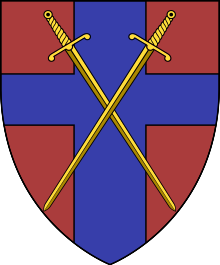Loading AI tools
Inactive occupation formation in Germany From Wikipedia, the free encyclopedia
British Army of the Rhine (BAOR) was the name given to British Army occupation forces in the Rhineland, Germany, after the First and Second World Wars, and during the Cold War, becoming part of NATO's Northern Army Group (NORTHAG) tasked with defending the North German Plain from the armies of the Warsaw Pact. The BAOR constituted the bulk of British forces in West Germany, and was a part of British Forces Germany (BFG). The BFG was made up of elements of the three services based in West Germany; the BAOR controlled Army units stationed there.
| British Army of the Rhine | |
|---|---|
 | |
| Active | 1919–1929 1945–1994 |
| Country | |
| Branch | |
| Part of | British Army Northern Army Group |
| Garrison/HQ | JHQ Rheindahlen, Germany |




The first British Army of the Rhine was set up in March 1919 to implement the occupation of the Rhineland. It was originally composed of five corps, composed of two divisions each, plus a cavalry division:[1]
II Corps: Commanded by Sir Claud Jacob
IV Corps: Commanded by Sir Alexander Godley
VI Corps: Commanded by Sir Aylmer Haldane
IX Corps: Commanded by Sir Walter Braithwaite and later by Ivor Maxse
X Corps: Commanded by Sir Thomas Morland
Cavalry Division (formed from 1st Cavalry Division)
Most of these units were progressively dissolved, so that by February 1920 there were only regular battalions:
In August 1920 Winston Churchill, as Secretary of State for War, told Parliament that the BAOR was made up of approximately 13,360 troops, consisting of staff, cavalry, Royal Artillery, Royal Engineers, infantry, machine gun corps, tanks and the usual ancillary services. The troops were located principally in the vicinity of Cologne at an approximate cost per month of £300,000.[2] The Cologne Post was a newspaper published for members of the BAOR during this period.[3]
From 1922 the BAOR was organised into two brigades:[1]
1st Rhine Brigade
2nd Rhine Brigade
The commanders were:[4]


The second British Army of the Rhine was formed on 25 August 1945 from the British Liberation Army.[5] Its original function was to control the corps districts which were running the military government of the British zone of Allied-occupied Germany. After the assumption of government by civilians, it became the command formation for the troops in West Germany only, rather than being responsible for administration as well.[6]
As the potential threat of Soviet invasion across the North German Plain into West Germany increased, BAOR became more responsible for the defence of West Germany than its occupation. It became the primary formation controlling the British contribution to NATO, after the formation of the alliance in 1949. Its primary combat formation was British I Corps. From 1952, the commander-in-chief of the BAOR was also the commander of NATO's Northern Army Group (NORTHAG) in the event of a general war with the Soviet Union and its Warsaw Pact allies. The BAOR's 50 Missile Regiment Royal Artillery was formerly armed with tactical nuclear weapons, including the MGM-52 Lance surface-to-surface tactical nuclear missile.[7] In 1967, the force was reduced in strength to 53,000 soldiers, compared with 80,000, ten years earlier.[8]
With the end of the Cold War, the 1993 Options for Change defence cuts resulted in BAOR being reduced in size, and in 1994 it became British Forces Germany.[9] This force, roughly 25,000 strong, was divided between Headquarters Allied Command Europe Rapid Reaction Corps, 1st Armoured Division, other combat support and combat service support forces, and administrative elements headed by United Kingdom Support Command (Germany). Garrisons which closed at this time included Soest (home of the 6th Armoured Brigade),[10] Soltau (home of the 7th Armoured Brigade)[11] and Minden (home of the 11th Armoured Brigade).[12]
Following the 2010 Strategic Defence and Security Review, the permanent deployment of British Army units in Germany was reduced. The last military base was handed to the German Bundeswehr in February 2020.[13]
The commanders were:[4]
Seamless Wikipedia browsing. On steroids.
Every time you click a link to Wikipedia, Wiktionary or Wikiquote in your browser's search results, it will show the modern Wikiwand interface.
Wikiwand extension is a five stars, simple, with minimum permission required to keep your browsing private, safe and transparent.